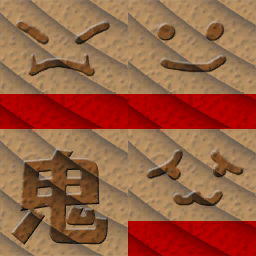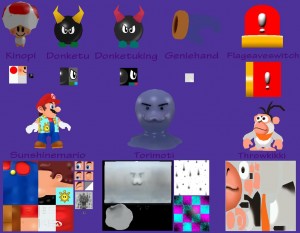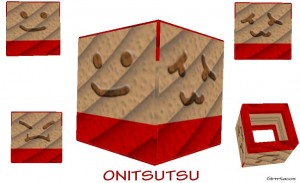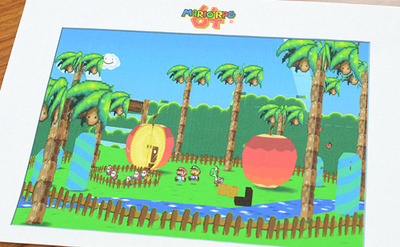![]()
Mario Galaxy is to this day, still considered one of the best games on the Nintendo Wii, and has most recently the BAFTA game of the year award (2009) . During it’s coverage over the years it has had two different versions shown to audiences during the beta stages. The initial beta which was demoed on playable booths at the GDC, E3 and etc, mainly seen in 2006. And the Pre-Release Beta, a series of images and videos used to tease the audience, closer to the final form of the game but with little suttle differences.
INITIAL BETA
The Initial beta was used as the first playable demo to audiences, it features many placeholders such as mario 64 soundbits as mario’s voice and various textures and gameplay elements. The HUD was also similar to that of Super Mario 64, using a 8 point health system rather than the tradional 3 point which became the final design, however this along with many other little changes were most likely put in to allow easier gameplay to the audience at the time. The limit to star bits (Called Star shards during the game, possible reference to the Kirby series.) was capped to 100 with a meter showing so, this was later scrapped to a 999 limit used in the final build.
Various gameplay mechanics were changed, such as boss monsters seen in the beta were easier to kill than those in the final. This may of been to help the audience at the events finish the level faster without being hit by the time limit. Mario was allowed to spin non stop, without the Luma needing to recharge, this may of been to help preserve the inital storyline as well to weaken the difficulty. Different characters who were vital to Mario’s progress had a speech bubble above their head to signal their importance, this may of been used to speed up the process of learning how to play while in game at the time.
Aside from little changes there were more noticable and intricate ones, such as the Star World galaxy, which used different music and was a compilation of various galaxies together. It was most noticable as the early version of the Good Egg Galaxy. The fight with Megaleg also didn’t feature the scene with Baby Bowser, although it was possible he wasn’t written into the game at the time it could of been to preserve storyline and plot details. A detailed model of the home planet from the Star World galaxy was found in the games code, however it wasn’t shown as anything other than a model. It is currently unknown is it is possible to play in this level via hack. There are also a number of odd items hidden in the games code, such as materials and models for unused items, such as a inflatble mushroom, various monsters and a odd blob like creature which may of served as a boss monster.
It shows the Starworld Galaxy, A test level of the game that was showed to the public at E3. I am going to go down into a list of what you can see there that never made it into the game
The level itself: The level shown was a combination of various galaxys like the Good Egg and the space junk. If you notice, the planet with the house is like the one in the Good Egg, but totally different. Here, the textures used on the land were different, more simple and not as complex like they are now. This is most likely due to the fact that Nintendo wanted a clean cut version out. Instead of the cardboard like textures that made it into the game you can see clear simple green on brown, Good and colorful.
Gameplay: Instead of using the cursor to pickup starbits, you had to hover over then and press B, this feature was taken out, also you can see that you could collect only 100 starbits in each level. This was taken out and changed to 999. When mario was shaken to attack an enemy, the Luma never popped in and out. Mario could spin nonstop, I believe that was either to keep the story hidden or wasn’t thought of yet.
CONCEPT ARTS:
Thanks to Mr. Game for the help with these images! In the Super Mario Galaxy Cellector’s Edition Prima Official Guide at the last pages is possible to find ORIGINAL CONCEPT ART made by the SMG developing team.
For example there are many pictures related to Mario’s Transformations


There are also two images showing how hard was to design Bees from Honeyhive Galaxy, Honeyclimb Galaxy and Gold Leaf Galaxy
The Penguins also should had a design more similar to Super Mario 64
Is also possible to find a concept design of the Starman Fortess, which 3D model you can find in the SMG’s files
From The Cutting Room Floor:
Starman Fort
A high-quality planet that was ultimately scrapped, much to the dismay of the development team. The two pipes on the planet are not warps but instead have the fully modeled tube interior, with the second pipe leading from the top of the tallest roof to the spherical underside of the planet. The yellow structure bears the same electric symbol as the ChargeSpot model. It, too, has concept art in the Prima guide. As can be seen by the concept art, it went through several incarnations, with the last two being left in the game files. The version seen in the concept art depicts features such as a snowy area and a construction site. it’s also interesting to note that this same image also shows BossCrab, Planet Disk, and three copies of the Star Planet. It also shows some generic spherical planets and the space ship planet used in Space Junk Galaxy.
A drawing of Mario on a beach at the sunset. For strange reasons, that beach is pretty, similar to the Hammerhead Beach from Banjo-Kazooie, a level that is strongly releated to Stop’N’Swop.
Other concept drawings:
Some Rosalina’s beta concept art along with its final version is also there:
Near Rosalina’s drawings, there’s also a beta castle drawing:
A drawing presenting Topmaniac’s Tribe in Melty Molten Galaxy is also present:
In the Game’s Disc there are also 3D models that indicates the presence of the Topmaniacs in Melty Molten.
At the very end of the book there’s also a handwritten note from Shigeru Miyamoto:
There’s something that Luma holds in her hand, even if there isn’t any Luma holding the wand in the final game. But there’s an unused beta 3D model, named “MagicalWand”; it’s possible that it isn’t a precursor to the Kamella’s Star Wand, but it’s a beta Luma’s wand.
PRE-RELEASE BETA
The Pre Release Beta was very similar to the final build of the game with just some small changes in things like level names, and mission names. Some Pre-Release beta videos also showed some missing elements such as small level details. A good example can be seen in the video below.
The over all picture is that alot of the beta was used as demonstration, various galaxies were shoved into each other as experimentation, like the Topmaniac fight in Melty Molten Galaxy. Various galaxies had different names like the Honeybee galaxy to Honeyhive, Gale galaxy to Gusty Garden. Also, various features switced places.
Some more beta stuff can be seen in these images:
Thanks to Mariowiki ke know that the Beta version of Super Mario Galaxy showed conjecturaly named species called Cosmic Toads, a kind of Toad that lives in outer space. They were supposed to live in Toad Houses in various galaxies. They told Mario how to use Launch Stars or would give him Star Bits. Rabbits were also going to be able to change into Cosmic Toads. The Starshade Brothers from Superstar Saga looked similar to them. Their role was likely replaced by Lumas. Also, according to one of the screenshots, Bowser was originally going to be fought on an arena on a magma planet instead of a glassy planet like in the first 2 battles. There was also going to be a giant green Pokey in the Dusty Dune Galaxy. It probably was replaced by Red Pokeys, and it resembled a Poison Pokey. Mario would also be able to lock onto boulders with the Star Cursor and stun them.
Thanks to Lord Deathsaur & SMBMadman for some of these screens!
Some unused models were found in the game. These include an old Toad model, two different Bullies, a blue and yellow genie’s hand (much like Master Hand,) a Red Switch, Mario’s model from Super Mario Sunshine, a creature resembling a blob of goo with a face, and the Party Monkey from Donkey Kong: Jungle Beat. The switch’s filename is flagsaveswitch, suggesting that it was used as a checkpoint of some type. The model of Mario only has his running, swimming, and waiting animations, meaning it may have been an early placeholder before Mario’s Galaxy model was finished. The low-polygon model for the house in Ghostly Galaxy has two chimneys that the high-polygon model lacks. A weird smiling block can also be found. [Info from Mariowiki]

Thanks to Girrrtacos for the these unused models & texture! (check below for some videos by Goomther!)
If a player uses cheat codes to leave the cave in Deep Dark Galaxy’s Purple Coin star, they will find that the objects outside the cave are mostly gone or misplaced. These oddities include an entire Toad Brigade (the Yellow Toad is on the beach, standing on top of a blue structure not normally present anywhere in the game), there is a green pipe on the beach, a series of climbable poles and next to the Green Toad is an Amp, not present in any other star. [Info from Mariowiki]
You can check for more beta/unused at The Cutting Room Floor – Super Mario Galaxy article
More Mario Galaxy Unused Models:
[Gallery=2046]
Videos (Beta Boss?):
More Beta Videos (Thanks to David!):


































